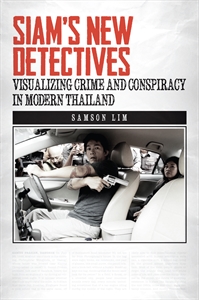Siam's New Detectives: Visualizing Crime and Conspiracy in Modern Thailand
- About the Book
-
Visual evidence is the sine qua non of the modern criminal process—from photographs and video to fingerprints and maps. Siam's New Detectives offers an analytical history of these visual tools as employed by the Thai police when investigating crime. Covering the period between the late nineteenth century and the end of the Cold War, the book provides both an extended overview of the development and evolution of modern police practices in Thailand, and a window into the role of the Thai police within a larger cultural system of knowledge production about crime, violence, and history.
Based on a diverse set of primary sources—police reports, detective training manuals, trial records, newspaper stories, memoirs, archival documents, and hard-to-find crime fiction—the book makes two related arguments. First, the factuality of the visual evidence used in the criminal justice system stems as much from formal conventions—proper lighting in a crime scene photo, standardized markings on maps—as from the reality of what is being represented. Second, some images, once created, function as tools, helping the police produce truths about the criminal past. This generative power makes images such as crime scene maps useful as investigative aids but also means that scholars cannot analyze them simply in terms of mimetic accuracy or interpret them in isolation for deeper meaning. Understanding how modern legal systems operate requires an examination of the visual culture of the law, particularly the aesthetic rules that govern the generation and use of documentary evidence.
By examining modern policing in terms of visual culture, Siam's New Detectives makes important methodological contributions. The book shows how a historical analysis of form can supplement the way many scholars have traditionally approached visual sources, as symbols requiring a close reading. By acknowledging the productive nature of images in addition to their symbolic functions, the book makes clear that policing is fundamentally an interactive, creative endeavor as much as a disciplinary one.
- About the Author(s)
-
Samson Lim, Author
Samson Lim is assistant professor of history at the Singapore University of Technology and Design.David P. Chandler, Series Editor
Rita Smith Kipp, Series Editor
- Reviews and Endorsements
-
- Tracking the histories of the paper and visual forms through which detective work travels (fingerprints, photographs, statistics, crime scene maps, reports, and re-enactments), Lim reminds periodically of detection’s other: ‘imaginations riddled with paranoia, haunted by rumor, driven by gossip, and organized by conspiracy theories.’ These are the rich entanglements of media circuits, detective fiction, and open secrets of deep politics that Lim calls the ‘detective state,’ nowhere more elaborated than in Thailand. One hopes Lim will continue his serial investigations into newer and newer forms of Thai truth-making out of the (un)available clues.
—Michael M. J. Fischer, Massachusetts Institute of Technology - With elegant prose and in meticulous detail, Samson Lim untangles the relationships among crime, evidence, aesthetics, and the visual in early twentieth-century Siam. Reading this book in early twenty-first-century Thailand, where the crisis of law is sharper than ever, his argument-- that the line between facts and how facts are visually represented is always muddled, and often with grave effect--is urgent and sobering. Forged through a novel methodology that brings an eclectic range of primary sources to bear on one another, including court documents, crime novels, newspaper accounts, and police training materials, Siam’s New Detectives also models an inventive way of writing history. Siam’s New Detectives makes a significant contribution to Thai and Southeast Asian Studies, as well as to law, criminology, and visual and cultural studies generally.
—Tyrell Haberkorn, The Australian National University
- Tracking the histories of the paper and visual forms through which detective work travels (fingerprints, photographs, statistics, crime scene maps, reports, and re-enactments), Lim reminds periodically of detection’s other: ‘imaginations riddled with paranoia, haunted by rumor, driven by gossip, and organized by conspiracy theories.’ These are the rich entanglements of media circuits, detective fiction, and open secrets of deep politics that Lim calls the ‘detective state,’ nowhere more elaborated than in Thailand. One hopes Lim will continue his serial investigations into newer and newer forms of Thai truth-making out of the (un)available clues.
- Supporting Resources
-










